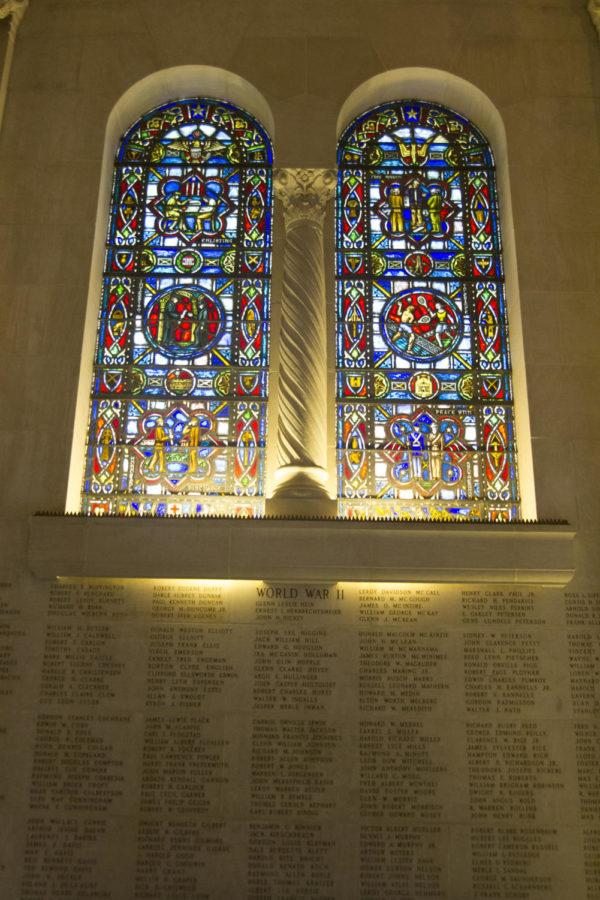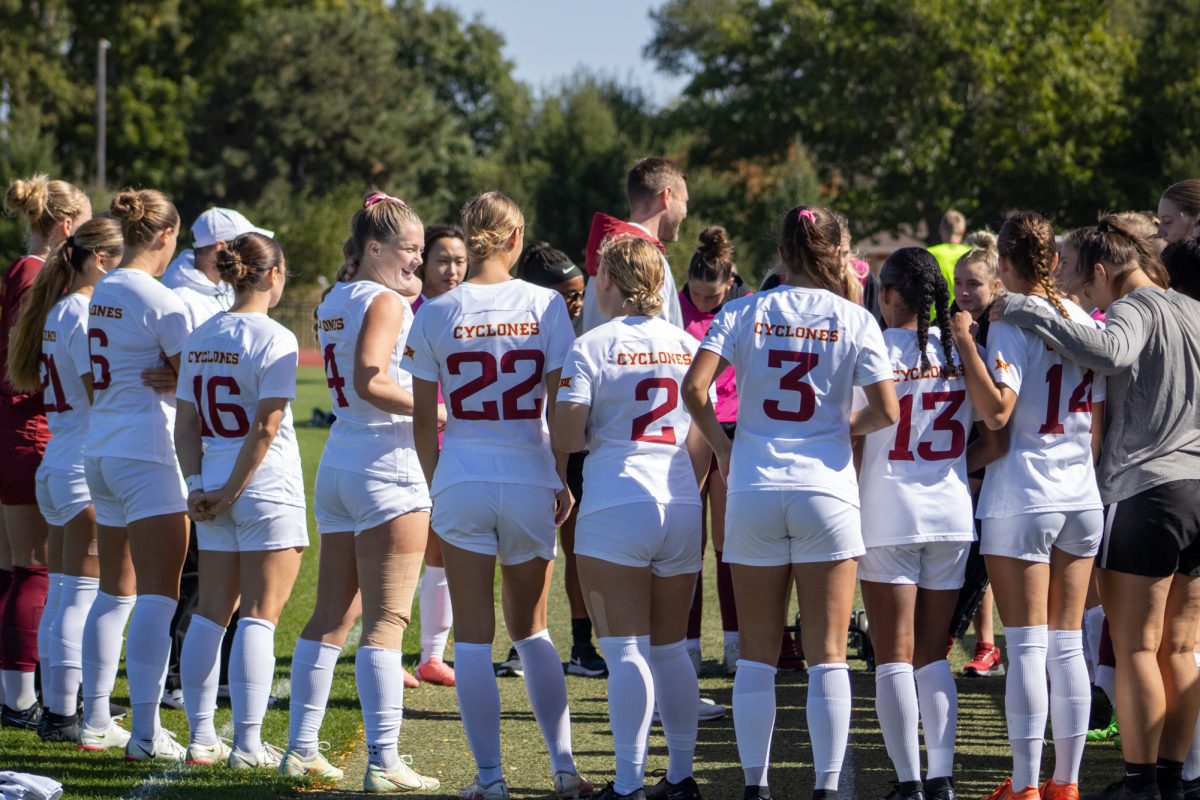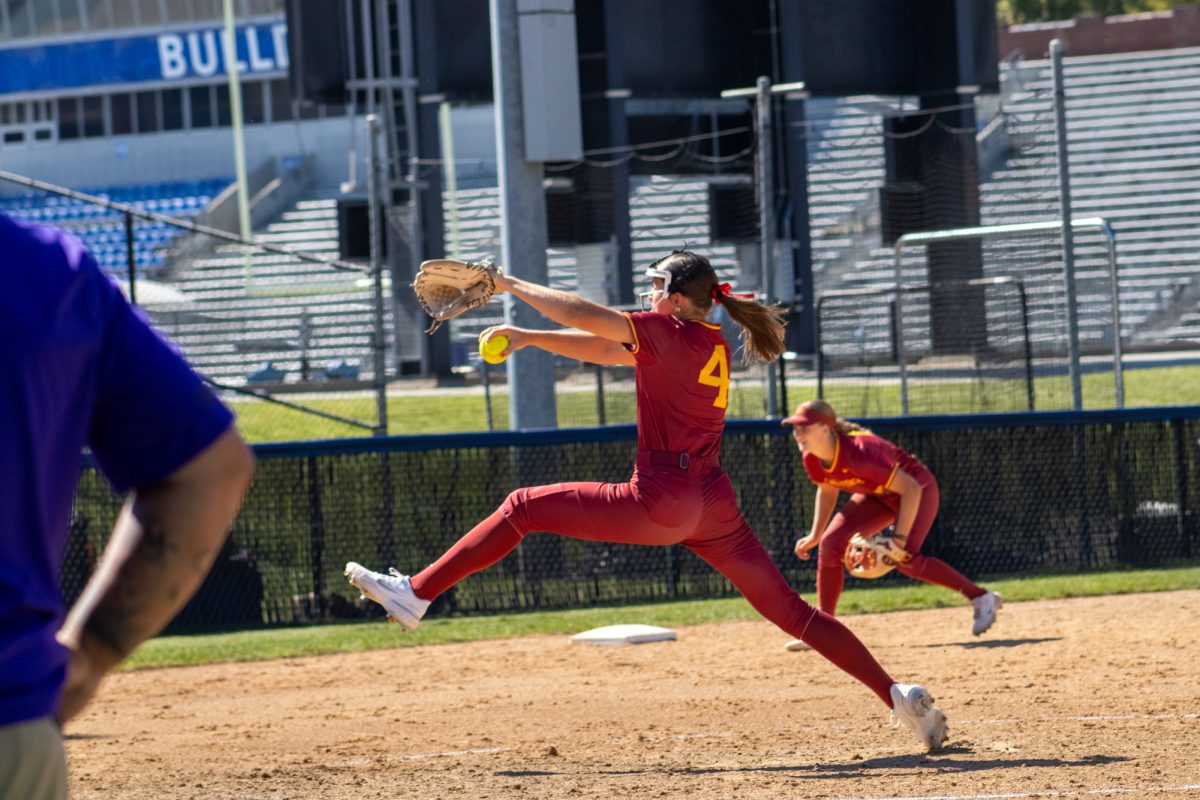Gold Star Hall pays tribute to fallen alumni
Photo: Blake Lanser/Iowa State Daily
As a part of the Gold Star Hall, an entrance to the Memorial Union, stained glass windows illustrate the primary virtues an ISU student should strive to have: learning, virility, courage, patriotism, justice, faith, determination, love, obedience, loyalty, integrity and tolerance.
April 28, 2015
In a single day, thousands of students, alumni, faculty and tour groups pass by the names of more than 500 people who lost their lives while serving America. The Memorial Union was built around Gold Star Hall, which hosts the memorial honoring those who died.
“We want the individuals we are honoring to come to life again,” said Richard Reynolds, director of the Memorial Union. “We want them to be remembered as being vital, active, young people.”
In 1919, students began talking about building a memorial for students who lost their lives in World War I. At the time, colleges around the nation were creating buildings dedicated to honor those who were lost in the war. The editor-in-chief of the Iowa State Daily proposed the idea of having a building paying respects to the fallen students.
“The Daily has a significant influence in terms to why this building exists,” Reynolds said.
After viewing a design proposal, the university agreed it didn’t reflect what it was looking for. The university returned to the architect who worked on Beardshear and other buildings around campus and asked him for help.
“He wanted to have a grand entrance, which reminded people daily, as they entered into the Memorial Union, why this building existed,” Reynolds said.
Unfortunately the architect was in poor health and never saw the opening of Gold Star Hall in 1928. However, his work is highly praised by architects from all over.
Multiple expansions of the Memorial Union caused natural light to be cut out of Gold Star Hall. The university decided to bring in an ISU alumnus in 1943 to create stained glass windows with artificial light representing the virtues of Iowa State: learning, virility, courage, patriotism, justice, faith, determination, love, obedience, loyalty, integrity and tolerance.
Within the integrity panel is an image of a nurse resembling Hortense Wind, the only woman honored on the wall. Once thought to be a nurse, Wind was later discovered to be a dietitian in WWI and is believed to have died of influenza.
After World War II, the names of the students killed in action were engraved on two bronze doors at the entrance of Gold Star Hall. The doors were removed in 1984 for accessibility issues and now reside at the Alumni Association. Those names were then transferred onto the walls of Gold Star Hall.
Reynolds explained how many relatives of Gold Star Hall members express gratitude for the memorial, however some realize their family member’s name had not been placed on the wall. In order to be recognized in Gold Star Hall, the member had to have died within the designated combat zone. However, post traumatic stress disorder and Agent Orange are not considered valid if a soldier’s death was after their time serving in combat zones.
James Olberding, member of Gold Star Hall committee, read a book regarding citizens who falsely claimed they served during Vietnam. Sparking his curiosity, Olberding began researching all of the names in Gold Star Hall.
He found there were names of men listed under the Vietnam column who never served. Olberding also found approximately 17 students who attended Iowa State and died in combat had been overlooked. Olberding started finding flaws with other names in different wars.
“Some people did not do a lot of good research and checking in those days,” Olberding said.
Soldiers who died in WWI, WWII, Korea, Vietnam, Somalia, the Global War on Terrorism [Iraq and Afghanistan] and USS Liberty are represented in the hall.
A wooden plaque honoring those who were involved in the Global War on Terrorism will be added to the wall in the future.
“As this chapter in our history comes to a close, we will engrave those names permanently,” Reynolds said.
Six years ago, the Gold Star kiosk project began in order to better tell veterans’ stories. As a story is completed it is added to the kiosk with pictures for the public to view.
“All [of] the sudden these names on the wall have an identity and they have a life,” Reynolds said.
The Gold Star Hall committee was created in the spring of 2014.
“We are very conscientious about contacting family members of those that we’re honoring, not only to get stories about these individuals from birth through their military experience, but we also contact those they served with to attend the Gold Star Hall Memorial,” Reynolds said.
A ceremony takes place on, or near, Veteran’s Day to honor the soldiers on the walls and those being added. The Gold Star Hall committee invites the family, loved ones and those who might have served with the members. The committee gives a platform for those attending to share stories or facts about the honorees.
“It’s hard to bring closure when the remains of the deceased are not physically present,” Reynolds said. “For some people, it’s a very healing ceremony that brings closure during a very difficult time.”
Before walking into Gold Star Hall, there is a subtle reminder to remove hats and pay respect to those who are named on the wall, however, some students forget to recognize its importance.
“There is still a reverence for the space,” Reynolds said. “I think just architecturally [it] just sends a message that this is a special place that requires an honor.”
Rachael Mueller, sophomore in event management, recognizes its importance.
“I know in the winter when I wear a hat, I take it off,” Mueller said. “I’m really respectful because I know it’s pretty important and has a lot of meaning to a lot of people.”







